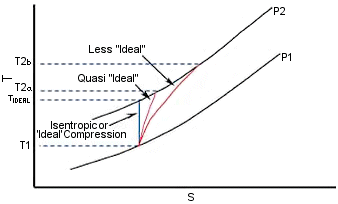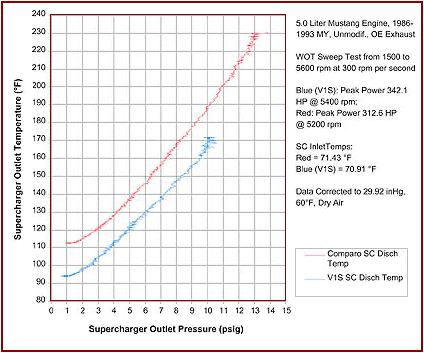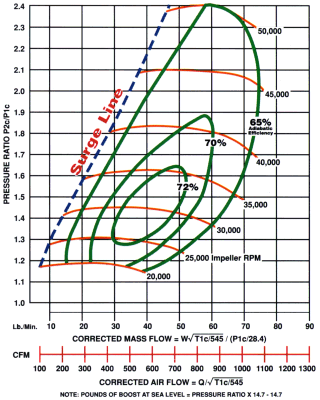 |
On the Subject of Supercharger Testing and Compressor Efficiency |
Introduction
Testing
is absolutely essential to the product development process, and the need to test
supercharger products is no different. On
the technical side, the development engineer must know if his design and product
execution meets specifications. For
example, were his initial assumptions correct? What about modelling and simulations conducted during the design process
– were these calculations correct, and does the actual performance, in fact,
validate them? From the consumer’s
perspective, he wants to know what level of performance he can expect from his
hard earned dollars. Will this
supercharger perform as advertised? What
power levels can I expect to gain? How
does one manufacturer’s products stack up against another’s? The bulk of these very legitimate questions can be answered through
testing. Further, the efficiency of
a supercharger (compressor) can only be determined through appropriate bench
testing, conducted in accordance with an adopted standard. Fortunately, the science behind testing of turbo machinery products, like
centrifugal superchargers, is mature and has benefited from many years of
development. It is through the
correct and consistent application of test discipline that both engineers and
consumers alike can be presented with trustworthy data to assess supercharger
performance.
Purpose and Intent
The
purpose of this paper is to review, discuss and educate readers on the subject
of supercharger testing and the importance of compressor efficiency. Although there is a need to delve into some rather advanced engineering
topics such as thermodynamics, we will make all attempts to restrict the use of
intimidating terms and nomenclature. Hopefully,
you, the reader will come away from this paper with a more detailed
understanding of supercharger testing, why it is important, how to interpret
test data and how you may benefit from having good test data. We believe this can only help you to meet your performance goals and make
a better choice when evaluating products.
Fundamentals
Before
discussing the finer points of supercharger testing, it might be prudent to
first review a few fundamental topics of supercharging, effects on engines, and
perhaps more importantly, what specific supercharger performance parameters
should be evaluated during a test. This,
then, established the primary criteria against which one can evaluate and
compare products.
Supercharging
101
First,
the fundamental purpose of supercharging: A
supercharger increases the gas (air) density at the inlet to the engine. That’s it in a nutshell. Now,
we have all heard about how a supercharger “forces” air into an engine, or
“pumps” more air in, etc. The
engine, of course consumes more air and, with the proportionally correct amount
of additional fuel, will make more power. Although
the distinction may be subtle, embracing this fundamental principle is
important. Here’s why:
- An
engine will “pump” a fixed volume of air, at a given speed, assuming WOT
operation. This volumetric flowrate, of course, is entirely dependent or the
engine size, speed, and volumetric efficiency. Items such as tuned intake and exhaust systems, ported cylinder
heads, modified camshaft profiles and the like are all designed to improve
volumetric efficiency, which increases power.
- The
AIR MASS flowrate through the engine is a product of inlet air density and
the volumetric flowrate. So, this means that for any given engine, one very effective way to
get more air through it is to increase the density of the air available at
the inlet.
- With
increased AIR MASS flowrate, we can now add the correct amount of additional
fuel and produce more power. The important distinction is that power strongly depends on air
density, i.e., the amount of oxygen available in a given volume to combine
with fuel.
- Since
superchargers increase the inlet air density to the engine, they
are also and often referred to as “compressors”.
Thermodynamics
of Compression
Let’s
turn things up a notch and introduce a little more science. Figure 1 is called a temperature-entropy or “T-s” diagram, and is
useful for mapping the thermodynamics involved during a compression process. Let’s say that “P1” is some low pressure, approximately 15psia
(standard sea-level pressure is 14.69 psia). “P2” is a higher pressure, and we’ll assume it to be 30 psia. So, the “compression” is from P1 to P2. If this compression occurs along a vertical line on the T-s diagram, it
is termed “isentropic”, which means this it is “ideal” or perfect. In other words, it occurs with no losses. We can also see that the temperature of the air (gas) also rises with
compression, and that even an isentropic or ideal compression process results in
a temperature rise. Note also that
some refer to this as the “heat of compression”. This behaviour follows the “ideal gas law” relationship, which
relates the pressure [P] temperature [T] and volume [V] of a gas with a constant
of proportionality, called the gas constant [R]. Further, there are man possible processes that can occur, but all result
in greater temperature rise than the “ideal” process as it is impossible to
construct a machine to produce a completely loss-less, or perfect compression.

Figure 1 – T-s diagram of compression process. Even
“Ideal” compression results in temperature rise, according to the ideal gas
law. As process becomes less ideal,
i.e., less “efficient”, temperature rise becomes greater. All processes, however, result in the same pressure, P2.
1
This, by the way is not Boyles Law. Robert
Boyle, in 1662, studied the effects of pressure and volume at constant
temperature on gasses. The more
generalized ideal gas law results from a combination of Boyle’s relationship
(PV = constant, when temperature is constant), and others. See www.chm.davidson.edu/ChemistryApplets/GasLaws/index.html for more info.
The
Importance of Compressor Efficiency
As
the “gold standard” would be the (impossible to achieve) ideal compression
process, we can now consider more realistic compression processes that involve
actual compressors or superchargers to accomplish the compression work. In this sense, we consider the “efficiency” of the actual compression
process relative to the ideal process, and call this the “isentropic
efficiency”. Now, an isentropic or
ideal process would also be 100% efficient. Actual compressors, therefore operate at efficiencies below this level. Also, the further a process deviates from the ideal, the less efficient
it becomes, and, the greater the temperature rise. So as depicted in Figure 1, the process resulting in T2b is less
efficient than T2a.
Now here’s the
rub:
- A
less efficient compressor produces less density rise, at the same pressure. This follows from the ideal gas law relationship:
D
= P/RT
- A
less efficient compressor absorbs more crankshaft drive power, at the same
pressure and flowrate.
- Therefore,
and given these two properties, the
most efficient compressor will produce the greatest net-power gain potential
on the engine.
The Essentials
From
the foregoing discussion, we can see that compressor or supercharger efficiency
must be at the top of the list of tested parameters – the engineer must be
able to test the efficiency of his compressor design in order to assess how well
he accomplished his job. The
consumer, on the other hand, ants the greatest potential net-power gain for his
money. This, he will want to compare
the tested efficiencies of various competing products and decide accordingly –
choosing the most efficient product will deliver the greatest potential
net-power gain. Other important
performance parameters, which can only be determined from controlled tests
include:
- Range – This refers to the stable or useable flow range, when operating at a
constant speed. Typically, the
lowest flow point of a centrifugal compressor is the “surge” line, where
operating instabilities occur. At
the high-flow end is the “choke” region, where the compressor can no
longer maintain pressure. At
either of these extremes, efficiency drops-off rapidly and overall
performance suffers.
- Pressure – Clearly an important property as the fundamental purpose of the
compressor is to develop increased pressure. So, testing for pressure performance would entail operating at
various impeller speeds from minimum to the safe maximum, and measuring
pressure performance and the corresponding efficiency levels. It should be noted that some compressors by design cannot develop
high pressure while also maintaining good efficiency; the temperature rise
combined with the increased drive power, in fact, may be so excessive that a
net loss in engine power may result.
- The
pressure versus Flow Behaviour – Relevant to more advanced studies,
this refers to the shape of the individual pressure vs. flow curves. In many cases, a flat performance curve may be preferred as this
offers improved flexibility for matching the compressor to various engines. Again, testing is required in order to accurately characterize.
SAE
J1723 Test Standard
The
SAE has published a Surface Vehicle Standard for testing automotive supercharger
products entitled “J1723 Supercharger Testing Standard”, issued August,
1995. J1723 has also been submitted
for recognition as an American National Standard, per the American National
Standards Institute (ANSI).
Why
a Standard?
The
most fundamental reasons behind not only adopting a test standard but also
adhering very closely to it is so that products may be evaluated in a consistent
and repeatable manner, against a common set of criteria, so that the results may
be compared directly. For example,
the automotive OE community uses the SAE J1349 test standard to obtain, correct
and publish engine net horsepower ratings. This
means that engine power claims may be compared across all manufacturers. Further, if an adopted standard is used at one test facility, then the
same results will be obtained at a different facility, when using the same
standard while testing the same product. This
means that tests will produce results that are repeatable, when adhering to the
standard. Lastly, the consumer
benefits when he has available performance data on competing products, obtained
through tests conducted in accordance with a standard. This way, he knows for certain that he can, without bias, compare product
performance across all manufacturers that use the standard and publish the data.
J1723
– An Overview
J1723
applies to the various types of available superchargers, including roots,
screw/Lysholm, and centrifugal-type products. It applies to bench testing and has been adopted by the SAE to specify,
among others:
- A
standard basis for supercharger efficiency rating
- Reference
inlet air supply test conditions
- A
method for correcting observed efficiency to standard conditions
- A
method for presenting test results in an accurate and usable way
- A
method to compare superchargers without the effects of engine dynamics and
intercooling
Strict
requirements are set forth regarding the necessary laboratory equipment, test
measurement and accuracy, installation of the test article(s), test conditions,
and presentation of results. Some of
the important instrumentation requirements include:
- Test
Sections –
Appropriately matched inlet and discharge test sections, of specified
diameter and length, must be used. Each
of these shall be equipped with multiple temperature and pressure probes
installed at precise locations. Pressure
measurements shall be +/- 0.5kPA (generally 0.1%) accuracy or better. It is further required that the discharge test section be insulated
between the supercharger and at least 1 diameter beyond the outlet
temperature measurement location.
- Inlet
Flow – A
flow measurement device, with 1 or better accuracy is required.
- Torque
Meter - +/-
0.5% or better accuracy required. This
is for measuring mechanical drive power to the supercharger and determining
mechanical efficiency.
- Speed/Tachometer - +/- 0.2% or better accuracy. During
tests, input test speed shall not deviate more than +/- 0.2%, or +/- 10
revs/min, whichever is greater.
Stabilization
Requirement
In
order to obtain accurate and repeatable results, the supercharger must be
operated at a fixed speed and flow setting, and all temperature readings must
completely stabilize before a data point can be logged. Stabilization is essential in order to obtain accurate and repeatable
measurements. Further, and in the
case of testing centrifugal compressors, thermal stabilization means minimum
heat transfer from the compressed air occurs, and the adiabatic assumption is
supported. Given these, and only
these conditions, an accurate and repeatable efficiency measurement can be made.
Some
Misconceptions
Believe
it or not, there are some in the supercharger industry who contend that the
J1723 standard is flawed and inappropriate for evaluating automotive
supercharger products because it “… does not account for the dynamic
operation of a supercharger in actual use.” This is further compounded by the
belied that a supercharger may conversely run cooler, i.e., somehow become more
efficient when operating on the vehicle, even though it tests poorly in the test
cell. This erroneous thinking is
apparently due to the requirement that the supercharger be operated at fixed
speed, flow, and pressure until fully stabilized, before a data point can be
logged, per the standard. This is
quite unlike the normal, dynamic operation when installed on a vehicle. Interestingly, other test codes such as the ASME PTC-10 also require
stabilization; this particular test code has been a mainstay of industrial
compressor testing for decades. Nonetheless,
such arguments readily collapse given the following realizations:
- Efficiency
performance is entirely dependent on the design of the compressor – poorly
designed compressors perform poorly, whether operation is continuous and
stabilized, or dynamic.
- Given
the same input drive speed and air-flow rate, a compressor will not consume
any less drive power when installed under the hood, than it does in the test
cell
- A
more efficient compressor, on the other hand, will always deliver cooler
charge air and consume less engine power than an inefficient compressor, at
the same (flow and pressure) operating point. This fact holds whether the compressor is running continuously at the
operating point, or rapidly “sweeps” through it.
- More
insight is afforded upon examining dynamometer test data. Figure 2 depicts the discharge temperature versus boost performance
for two supercharger products, a Vortech V1S trim with a curved discharge,
and a comparison centrifugal supercharger product. The data for both compressors was obtained from an engine dynamometer
sweep test, with each supercharger mounted on the same engine. The V1S attains a peak efficiency of 71% when tested per the J1723
standard. The competing product,
61%. Inlet temperatures were
within 0.5F for the dyno test. From
the plot it is clear that the V1S exhibits cooler discharge temperatures
than the competing product, even under these dynamic operating conditions. This is because it is a more efficient compressor, as the J1723 test
indicates. This also means that
a hotter running compressor on the test stand will also run hotter (than a
more efficient compressor) on the engine.

Figure 2 – Discharge temperatures of Vortech V1S Trim with curved discharge (71%
efficiency) and a comparison centrifugal
supercharger (61% efficiency) when operating on an engine dynamometer sweep
test. 5.0 Litre Mustang engine; 1500
RPM to 5800 RPM in ~ 15 secs. Inlet
air temperatures are within 0.5F. Vortech
V1S delivers cooler charge air at a given boost level than competing product.
Compressor
Maps
A
compressor map is the product of a completed J1723 test. This map presents the most significant performance result from testing in
a very clear and useful manner. Multivariate
data are displayed and include the pressure versus flow curves, each obtained at
a fixed operating speed, and the all-important iso-efficiency contours, which
are also referred to as efficiency “islands”. The term “map” is quite appropriate as, usually, the useful operating
range of the compressor is displayed in its entirety and full knowledge of
compressor performance can be obtained at any specific operating point. With a compressor map, one can also over-plot an engine air demand curve
and determine whether the compressor is suitably matched to the engine. An example of a compressor map is shown in Figure 3.

Figure 3 – Compressor map for Vortech V1S-Trim Supercharger, Peak operating efficiency
(island) of 72% is attained. Compressor
can attain at least 65% efficiency up to a Pressure Ratio (PR) or 2.4; with flow
up to 75 lbm/min. Compressor can operate outside of this range, but at reduced
efficiency.
Speedlines
These
are lines of constant speed operation on the map, and indicate pressure rise vs.
flow, at the indicated impeller speed. The
lines are constructed by taking 5 to 7 data points, at various flows from surge
to choke, and fitting a curve to these data to form the line. To develop a complete map, multiple speed lines are constructed to cover
to the operating speed range of the supercharger. This also minimizes inaccuracies arising from interpolating the data. Thus, many stabilized operating points (perhaps 50 or more) must be
logged in order to construct a complete map. This may consume several days in the test cell.
Pressure
Ratio (PR)
The
term “pressure ratio” is simply the absolute discharge pressure divided by
the absolute inlet pressure. By
plotting pressure rise as a ratio, one can quickly and conveniently determine
the discharge pressure of the compressor, when the inlet pressure is known. Further, in according to J1723, the PR is to be computed using the
stagnation or “total” pressure measurements. The total measurements differ from static measurements in that the
kinetic energy of the high velocity air is accounted for and incorporated. In essence, then, this computes the complete change in air energy state
from the compressor inlet to the outlet.
Efficiency
“islands”
For
each data point logged, there is also a corresponding efficiency. The efficiency “islands” are lines of constant efficiency, which are
over-plotted on the pressure vs. flow map. They
are obtained through a graphical construction process from the efficiency vs.
flow curves.
Data
Correction
Data
correction is extremely important if the data and/or performance maps are to be
useful. Correction is required so
that results of different tests, on different products can be compared directly
and in meaningful ways. Basically,
correction means: “…this is how the compressor would perform with inlet air
at 29.23 in-Hg abs. pressure and 537 °R” the J1723 standard conditions. Of course, one can correct data to other “standard” conditions; this
is yet another rationale supporting use of the J1723 standard.
Closure
Supercharger
testing is vital to the design and development process, and affords the consumer
meaningful ways to evaluate product performance. The SAE J1723 test standard established procedures, requirements, and
data presentation methods so that supercharger products can be accurately and
consistently evaluated. The
resulting corrected compressor map allows both engineer and consumer alike to
compare products from various manufacturers, without bias or need for more
complex interpretations.
Efficiency is perhaps the most important performance parameter of all, and the
J1723 standard provides for its accurate quantification. Increased compressor efficiency provided greater air density rise per
pound of boost, at reduced input power absorbed fro the engine crankshaft – a
double benefit. As the most
efficient compressor affords the consumer the greatest potential net-power gain
on his engine, the savvy customer would be well advised to request efficiency
test data, or better, a certified J1723 compressor map from a manufacturer
before making a purchase choice.
|





